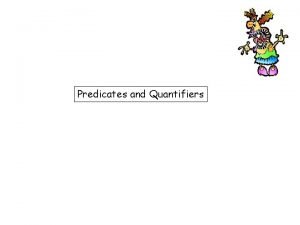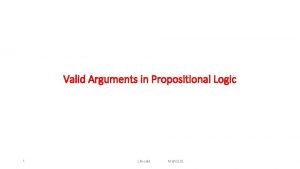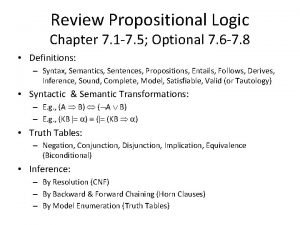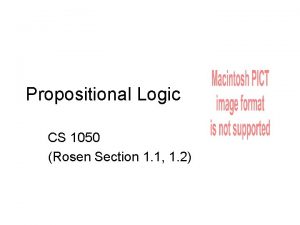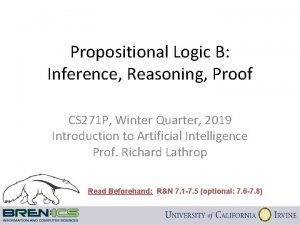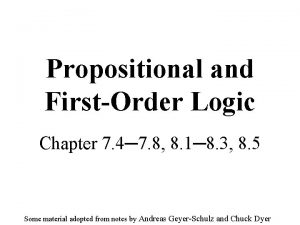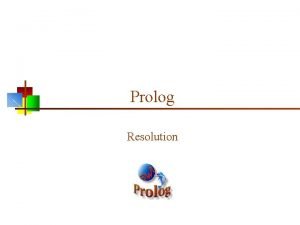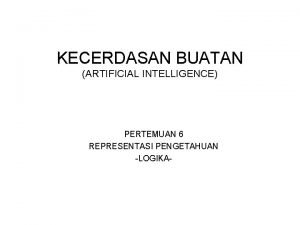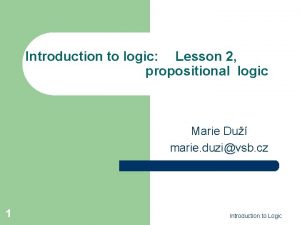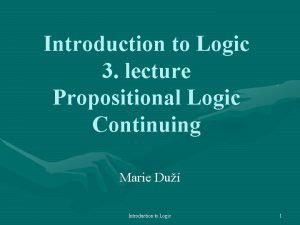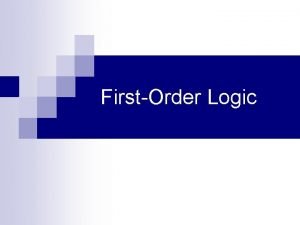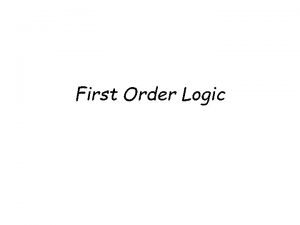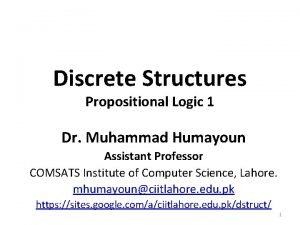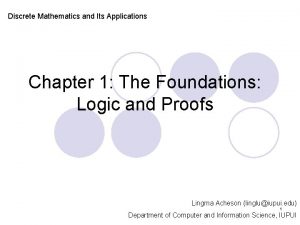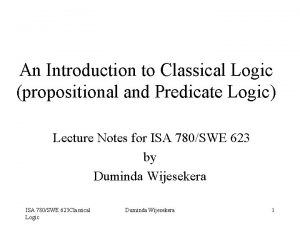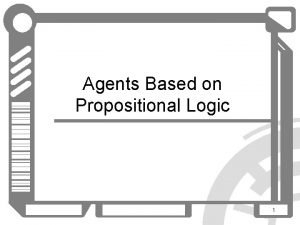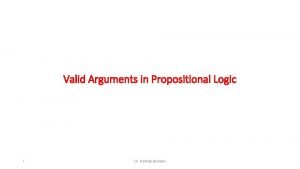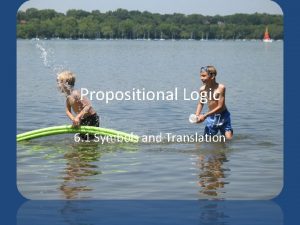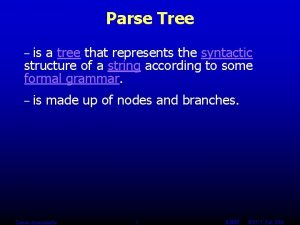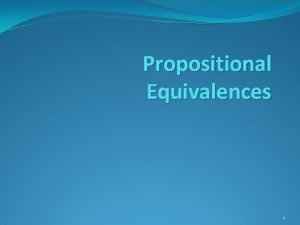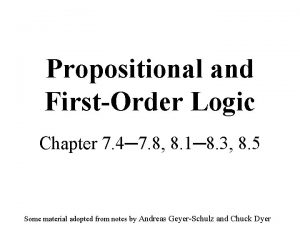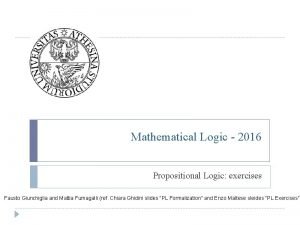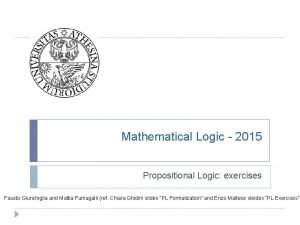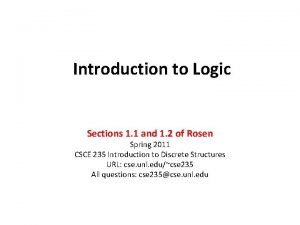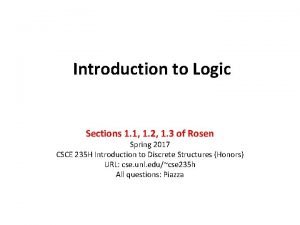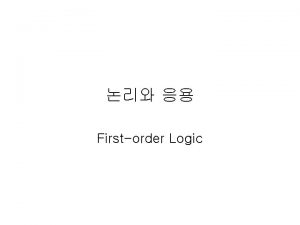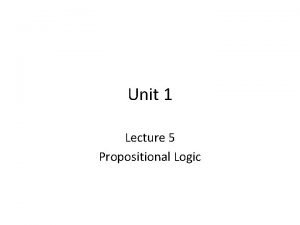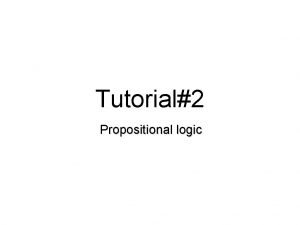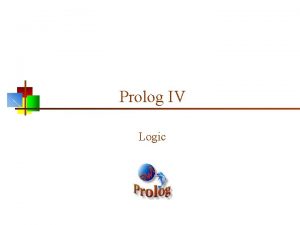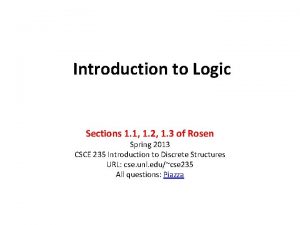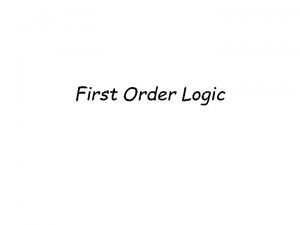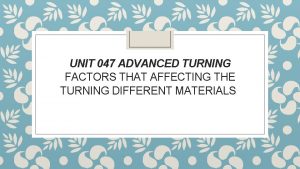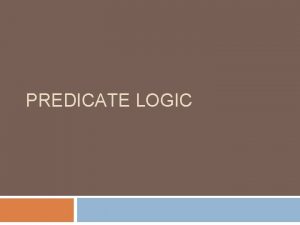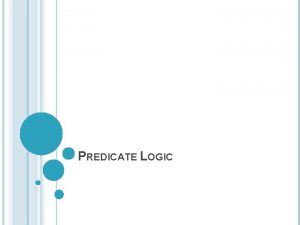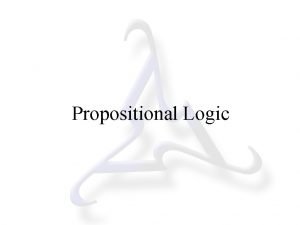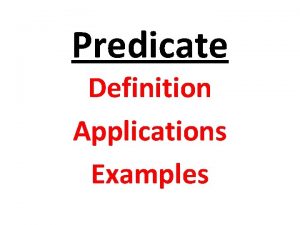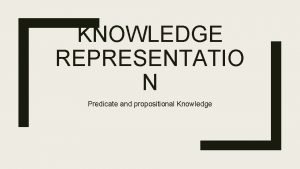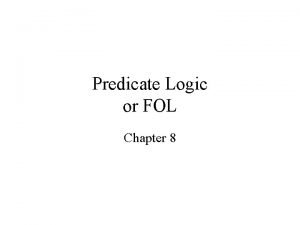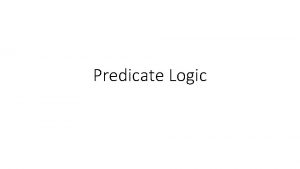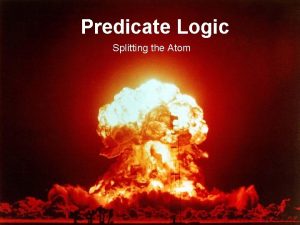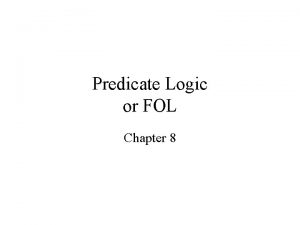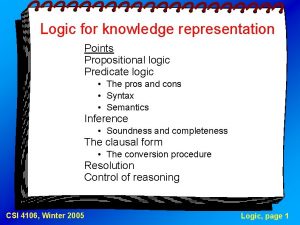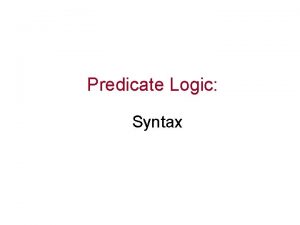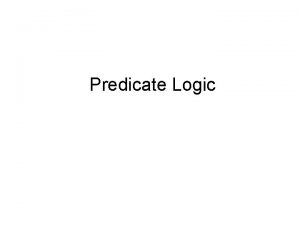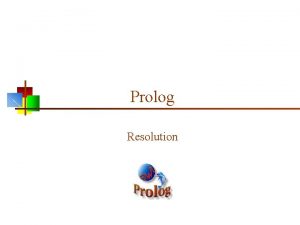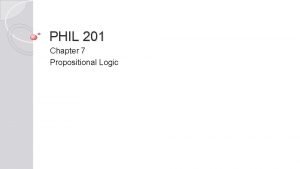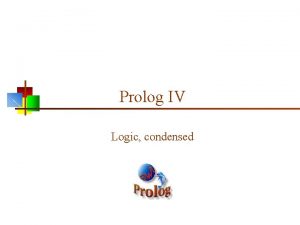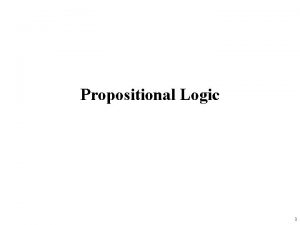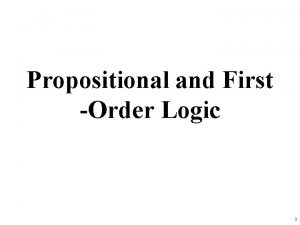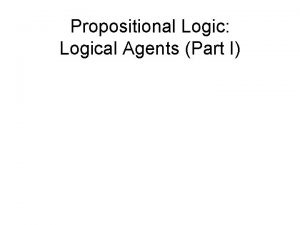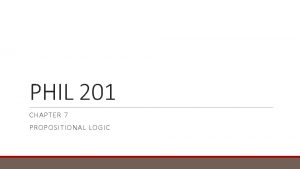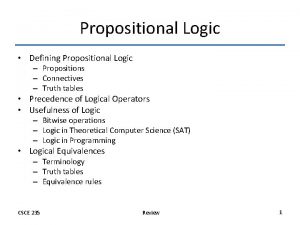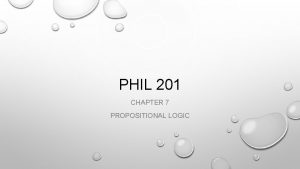Predicate Logic One step stronger than propositional logic









































- Slides: 41

Predicate Logic One step stronger than propositional logic Creative Commons License – Curt Hill

Introduction • What we have seen so far is called propositional logic • It includes axioms and theorems concerning the operators of Boolean Algebra • It lacks something • We want to strengthen this into predicate logic – AKA First order logic or predicate calculus Creative Commons License – Curt Hill

Statement Categories • In mathematics, there are three types of statements: – True – False – Open • True statements are usually characterized by: – Statements with only constants and a comparison such as = or > – A statement of fact – A tautology Creative Commons License – Curt Hill

True Statements • 5=2+3 • 5>2 • The United States won its independence from England • They may include variables in limited ways: – x+5 = 5+x – p q q Creative Commons License – Curt Hill

False statement • False statements have a similar form but are false • 5=4 • 2>5 • The United States won its independence from Germany • They may also include variables: – x (y z) x y x z –x=x+1 Creative Commons License – Curt Hill

Open statements • Open standards generally cannot have a true or false value until a variable is given a value • Almost all equations are open, the task of solving is finding a set of values that makes the statement true or determining that the set is empty • 5 x = 10 is neither true nor false • It is true if x = 2 and false otherwise Creative Commons License – Curt Hill

Discussion • Logic is two valued, we cannot allow true, false, and maybe • Therefore, we have to find a way to make a statement that is open into one that is true or false • We now use predicates – AKA Propositional functions – A predicate is a Boolean function Creative Commons License – Curt Hill

Predicates • Up to this point we have mostly dealt with variables and operators • We may also use predicates • Predicate is a fancy name for a function that returns a boolean value • It may have one or more arguments • The argument does not have to be a boolean variable • This is not startling since any boolean variable could hold the result of a predicate Creative Commons License – Curt Hill

An Example • Let P(x) be the statement x>8 • P(x) is still open • We may determine the truth value of: – P(12) – P(2) • If the predicate is arbitrary, single letter names are sufficient • We may have others as well Creative Commons License – Curt Hill

Naming • Mathematicians seldom need to consider large real-world problems • Thus, they tend to use single letter predicates to keep the notation easy • Computer Science is an area where we want to describe these, so many variables or predicates may exist • More descriptive names are then needed • This also explains using parenthesis for arguments Creative Commons License – Curt Hill

Mathematicians v. Computer Scientists • prime(n) – The argument n is prime or not • student(p) – A person p is a student at VCSU or not • odd(n) or even(n) • Predicate names generally are single word • This word should indicate the purpose Creative Commons License – Curt Hill

Predicate Notation • As always there are multiple ways to represent the same thing • I prefer: predicate(parameter 1, parameter 2) – This matches programming notation • Others use single letter predicates with subscript indicating parameter: Gx • Thus P(x, y) or Px, y Creative Commons License – Curt Hill

Usage • One of the uses of predicates is in program and statement specifications – Correctness proofs as well • We express the precondition and postcondition of a statement using this notation – Precondition captures the state before a statement is executed – Postcondition after Creative Commons License – Curt Hill

Example • Consider the statements: if(x>0) x = x+1; • Since we know nothing about the context the precondition must be simply T as in True • However, the postcondition would be: (x 1) Creative Commons License – Curt Hill

Example Again • Recall these statements: if(x>0) x = x+1; • Suppose that P(x) denotes x>0 • Moreover, x 0 is the value of x before the statement • The postcondition becomes: P(x) x=x 0+1 P(x) x=x 0 Creative Commons License – Curt Hill

Open Statements • In a real sense we have skirted the Open statement problem • P(x) is just as open as x>0 • We next need quantifiers to say something useful about the possible values Creative Commons License – Curt Hill

Quantifiers via familiar example • You are probably familiar with summation notation – It gives us a compact way to express an infinite sum or even a large finite sum • This gives us a convenient way to denote the sum of a finite or infinite number of terms • We also have a similar notation of products Creative Commons License – Curt Hill

Summation and Product Creative Commons License – Curt Hill

Logical Quantifiers • Just at the denotes repeated addition and the repeated multiplication, so we have symbols for And and Or • is the universal quantifier – Possibly infinite number of terms connected by • is the existential quantifier – Number of terms connected by • A quantified expression, like a proposition, still has a true or false value Creative Commons License – Curt Hill

Universal Quantifier • Notation: – x. P(x) – Read: for all x, P(x) • The x is a dummy variable – It has an implied domain or range based on its type • This is the same as: P(x 0) P(x 1) P(x 2) P(x 3) … – Through potentially infinite terms Creative Commons License – Curt Hill

More • The term, P(x) may also be more complicated than a single predicate • Most of the time the type of the dummy is real numbers – We may just infer the type and range – They may be explicitly stated outside of the quantified expression – Like the universe of discourse of sets, not always stated • We may also specify them explicitly Creative Commons License – Curt Hill

Explicit domains • We are able to specify them as part of the quantification: x(P(x) x x>0) • Sometimes this is abbreviated into the dummy declaration x>0 x P(x) – This is the textbook’s preference – Recall the difference between mathematicians and computer scientists Creative Commons License – Curt Hill

Existential Quantifier • • Notation: x. P(x) Read: there exists an x, P(x) This is the same as: P(x 0) P(x 1) P(x 2) P(x 3) … – Through potentially infinite terms • The dummy variable and term rules are the same Creative Commons License – Curt Hill

Number? • The existential quantifier is true if one or more x’s make the condition true – We are only stating that there is at least one • An infrequently used quantifier is that uniqueness quantifier states that there is one and only one: – !x. P(x) Creative Commons License – Curt Hill

Notation • This is not the only notation, another is: (OP i: r: t) • OP is an operator which is commutative, associative, and binary • How many do we have? • i is a list of dummies – Often just one but sometimes more • r is the range • t is the term Creative Commons License – Curt Hill

Open Questions Again • We now have a way to reduce an open question into a true false proposition • The open question: 3 x + 5 = 5 x - 11 • Becomes x 3 x + 5 = 5 x – 11 • This statement may be true only if a solution exists or false otherwise – No longer open Creative Commons License – Curt Hill

More on quantifiers • Quantifiers allow us to state things that are not directly expressible with just predicates, variables and the operators • In practice this should allow us to state almost any real-world fact or supposition • A predicate may be defined in terms of a quantifier Creative Commons License – Curt Hill

Precedence • The quantifiers have higher precedence than any of the logical operators • Thus: x. P(x) Q(x) is ( x. P(x)) Q(x) and not x(P(x) Q(x)) Creative Commons License – Curt Hill

Variables • There are two types of variables in a quantified expression: bound and free • A bound variable is part of the quantifier – It ranges over some set of values as part of quantification – These are often known as dummies • A free variable exists outside the quantified expression – These require a value, otherwise the quantifier is still open Creative Commons License – Curt Hill

Variable Example • Consider: x(P(x+y) Q(x+y)) • The variable x is a bound variable • It may only have a certain set of values determined by the quantifier • The variable y is free – It may take on any value – The y variable must be given a value outside of the expression for this not to be open Creative Commons License – Curt Hill

Variable Scope • The scope of a variable is that part of the expression where it is known • In any quantified expression the bound variables have a scope contained by the quantifier • This occasionally gets messy when a quantified expression contains another quantified expression Creative Commons License – Curt Hill

Equivalences • Since quantifiers have the same characteristics as propositions, we may consider equivalences with them as well • Some of these will considered Creative Commons License – Curt Hill

Distribution • x(P(x) Q(x)) x. P(x) x. Q(x)) – This is distributing a universal quantifier over a conjunction • Similarly, we can distribute an existential quantifier over disjunctions x(P(x) Q(x)) x. P(x) x. Q(x)) • Does existential distribute over conjunctions? x(P(x) Q(x)) x. P(x) x. Q(x)) Creative Commons License – Curt Hill

Negation • De. Morgan’s generalizes to quantifiers • i. T i T – T is any term or combination of predicates – Connects and – The outside negation may be moved across implication as well – i. T i T – i. T i T Creative Commons License – Curt Hill

Audience Participation • For each of the following: – Is it true? – What does it mean? – Assume Reals if no type is given • • • x 3<x x 2<x xx 0 = 0 xx+1>x x 1/x Creative Commons License – Curt Hill

English to Logic • Translating English statements to Logic statements is important but sometimes tricky – The ambiguity of English is a problem • Certain words translate in an obvious fashion – Every, all – Not – And – Or – The variety of ways to say the same thing complicates Creative Commons License – Curt Hill

Translation • All students in CS 161 have had CS 160 – x. C 160(x) – Where x is students in 161 and C 160 is a predicate – You might also use: x(C 161(x) C 160(x)) Creative Commons License – Curt Hill

Some quantifier examples • • Some apples are rotten a Apples rotten(a) All women are beautiful w Females beautiful(w) Some integers are positive All squares are rectangles Not all rectangles are squares Prime numbers exist in the integers Creative Commons License – Curt Hill

Prime Definition • Can we define a prime number? • prime(n) = i i > 1 i ≠ n 0 ≠ n-floor(n i)*i • floor truncates a real number to an integer • i is a dummy variable that can range over all integers greater than 1 and not equal to n • Notice that for this expression i is bound but n is free Creative Commons License – Curt Hill

Summary • What was open before (that is not possible to assign to truth value to) is now closed – We may not always know the truth value – We do know that one exists • We should now be able to state in a concise form any proposition Creative Commons License – Curt Hill

Exercises • Rosen 1. 4 • Problems: 5, 9, 15, 21, 25, 33, 39 Creative Commons License – Curt Hill
 Step 1 step 2 step 3 step 4
Step 1 step 2 step 3 step 4 First order logic vs propositional logic
First order logic vs propositional logic First order logic vs propositional logic
First order logic vs propositional logic Third order logic
Third order logic How a predicate function become a propositional function?
How a predicate function become a propositional function? Arguments in logic
Arguments in logic Propositional logic examples
Propositional logic examples What is a wff in logic
What is a wff in logic Xor in propositional logic
Xor in propositional logic Propositional logic notation
Propositional logic notation Implies in propositional logic
Implies in propositional logic Propositional logic in prolog
Propositional logic in prolog Propotional logic dapat digunakan untuk..
Propotional logic dapat digunakan untuk.. Well formed formula
Well formed formula Propositional logic notation
Propositional logic notation Pros and cons of propositional logic
Pros and cons of propositional logic Biconditional
Biconditional Discrete math propositional logic
Discrete math propositional logic Application of propositional logic
Application of propositional logic Components of mathematical system
Components of mathematical system The proposition ~p ν (p ν q) is a
The proposition ~p ν (p ν q) is a Semantics of predicate logic
Semantics of predicate logic Agents based on propositional logic
Agents based on propositional logic Valid arguments in propositional logic
Valid arguments in propositional logic Logic statements symbols
Logic statements symbols Parse tree propositional logic
Parse tree propositional logic Tautology, contradiction or contingency examples
Tautology, contradiction or contingency examples Propositional logic symbols
Propositional logic symbols Propositional logic exercises
Propositional logic exercises Propositional logic exercises
Propositional logic exercises Proposition in mathematics
Proposition in mathematics Propositional logic cheat sheet
Propositional logic cheat sheet ___________ is the limitation of propositional logic
___________ is the limitation of propositional logic Percept sentence
Percept sentence Propositional logic
Propositional logic Propositional logic examples and solutions
Propositional logic examples and solutions Propositional logic
Propositional logic P double implies q is equivalent to
P double implies q is equivalent to Biconditional proposition examples
Biconditional proposition examples Steel stronger than iron
Steel stronger than iron What is he that builds stronger than
What is he that builds stronger than Love is stronger than death poem
Love is stronger than death poem




